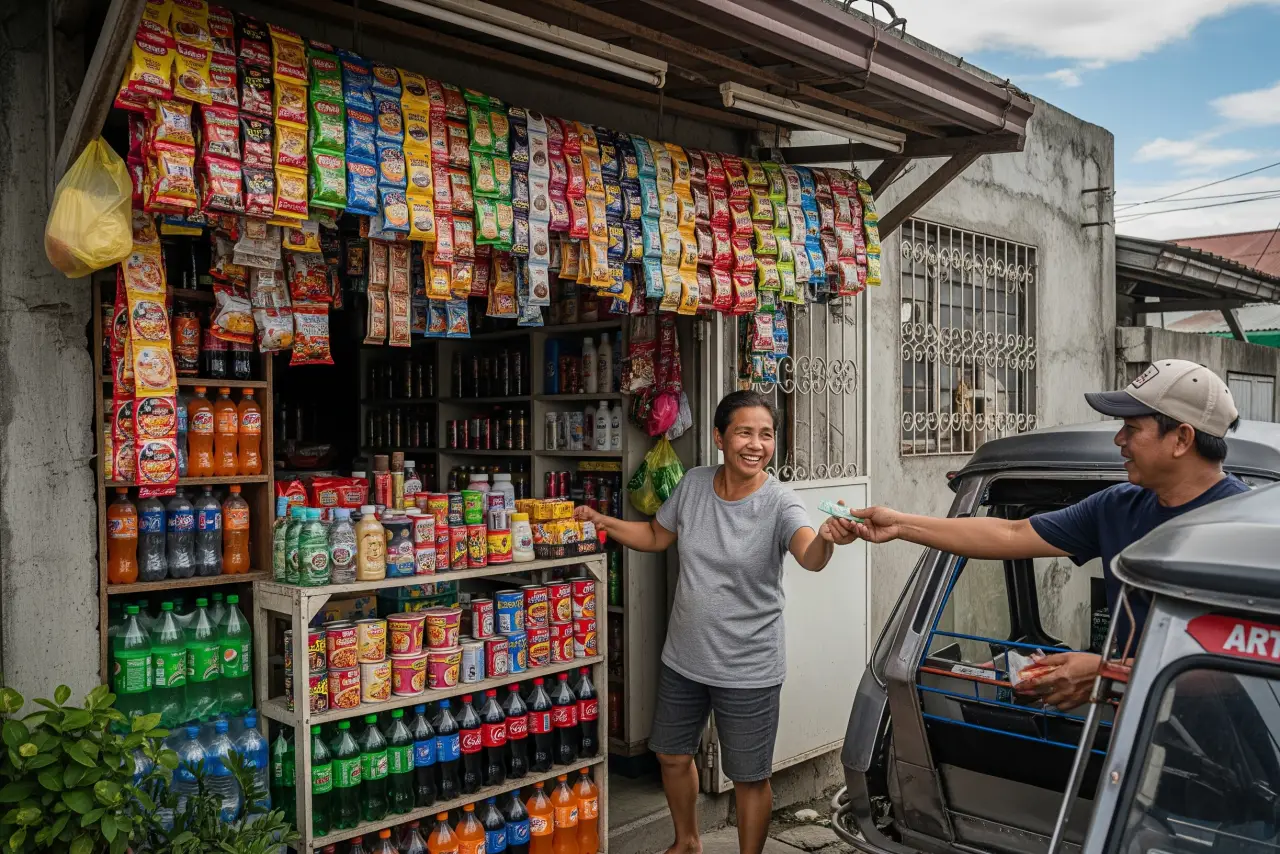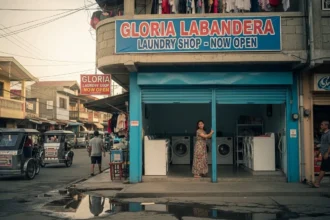You’ve seen sari-sari stores everywhere-but here’s the truth: in 2025, they’re still one of the most profitable small businesses for Filipinos. Even with supermarkets, convenience stores, and online shopping apps, sari-sari stores survive because they sell what Pinoys love most: convenience and tingi. A cold Coke, a single sachet of shampoo, a quick load top-up, or a pack of noodles-people want them now, and they want them nearby.
- 🏪 Why Sari-Sari Stores Are Still Profitable in 2025
- 💰 Capital Requirements – How Much Do You Need to Start?
- 📋 Permits, Registration & Legal Requirements
- 🛒 What to Sell – The Best Products for Sari-Sari Stores in 2025
- 📍 Location, Space & Store Setup
- 🛍️ Where to Buy Supplies – Best Sources for Sari-Sari Store Owners in 2025
- 💵 Income Potential – How Much Can You Really Earn from a Sari-Sari Store in 2025?
- ⚠️ Common Challenges & How to Avoid Them
- 🛒 Daily Operations & Smart Store Management
- 📣 Marketing Your Store – How to Stand Out in a Crowded Barangay
- 🚀 Growth & Expansion – From Tindahan to Mini-Grocery
- ❓ Frequently Asked Questions (FAQs)
- ❤️ From Window Counter to Family Cornerstone
The good news? You don’t need millions to start. With as little as ₱20,000–₱50,000, you can build a sari-sari store that serves your community and generates steady income for your family. This guide will give you a complete roadmap-from capital and permits, to the best products, supplier tips, suki strategies, income potential, and even how to grow into a mini-grocery.
If you’ve been looking for a negosyo that’s tried, tested, and close to home, sari-sari stores prove that sometimes, the simplest ideas are still the smartest.
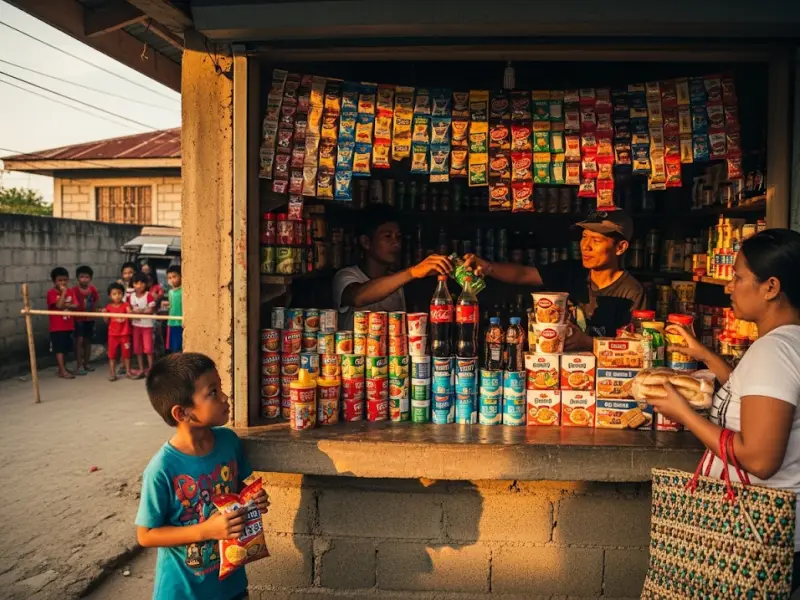
🏪 Why Sari-Sari Stores Are Still Profitable in 2025
Some people think sari-sari stores are “old school.” But look around-barangay streets are lined with them, and most are still alive and kicking. Here’s why:
- Everyday Essentials Never Go Out of Style
No matter how advanced online shopping gets, people will always need instant noodles, rice, sardines, coffee, load, and toiletries. And they’ll always prefer buying these in tingi (sachet) or small packs instead of spending a big amount in one go. - Convenience Beats Price
Sure, supermarkets might be cheaper per kilo or per pack. But who wants to ride a jeep just for one sachet of shampoo? Sari-sari stores win because they’re steps away from your door. That convenience is something Lazada, Shopee, or even 7-Eleven can’t replace. - Low Barrier to Entry
You don’t need a degree, fancy equipment, or huge capital. With as little as ₱20K, you can open a store in your garage or front yard. For many, it’s the most realistic negosyo they can start. - Cash Flow Is Daily
Unlike other businesses where you wait weeks or months to see money, sari-sari stores bring in daily cash. Even if it’s just ₱1,000 sales in a day, you can immediately reinvest and keep the cycle going. - Adaptability in 2025
Modern sari-sari stores now offer GCash cash-in/out, e-loading, bills payment, and even delivery via riders. Those who embrace these extra services earn more and keep their suki loyal.
👉 Bottom line: Sari-sari stores remain profitable because they provide what Filipinos need, when they need it, in the way they want it-tingi and convenience.
📊 Sari-Sari Store vs. Supermarkets vs. Convenience Stores
| Factor | Sari-Sari Store | Supermarket | Convenience Store (7-Eleven, Ministop) |
|---|---|---|---|
| Capital Needed | ₱20K–₱50K | ₱Millions | ₱Millions (franchise) |
| Location | Anywhere in the barangay | Malls or commercial hubs | Urban centers only |
| Customer Base | Neighbors, suki, locals | City-wide, middle-class shoppers | Urban professionals, students |
| Product Size | Tingi (sachet, single pcs) | Bulk packs | Regular packs |
| Price | Slightly higher per unit | Cheapest per kilo/pack | Higher than sari-sari |
| Convenience | Walking distance, open anytime | Farther, requires commute | 24/7 but only in select areas |
| Extra Services | Load, bills payment, GCash cash-in | None | E-wallet top-ups, bills payment |
👉 Why sari-sari stores win: They thrive because they fit Pinoy daily habits-tingi culture, instant convenience, and neighborhood trust. Even if prices per item are a little higher, Filipinos still choose sari-sari stores because they save time and effort.
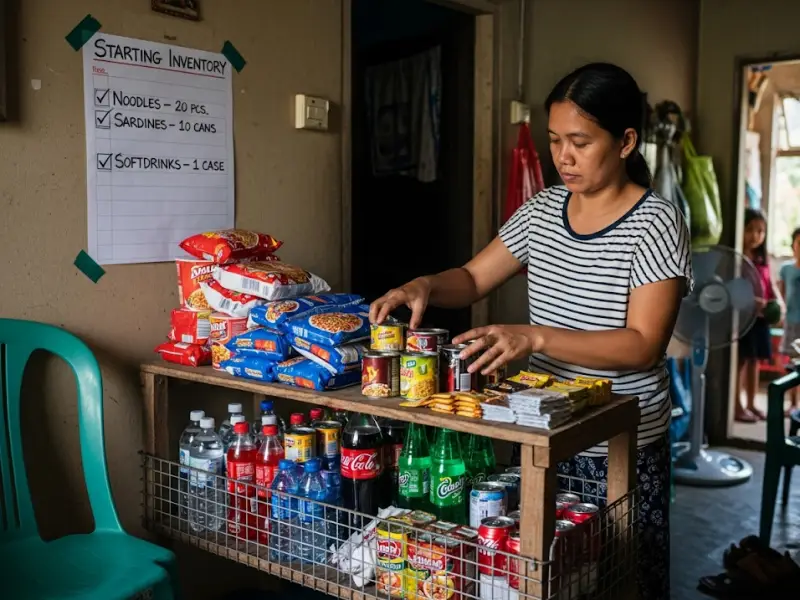
💰 Capital Requirements – How Much Do You Need to Start?
One of the biggest questions aspiring sari-sari store owners ask is: “Magkano ba talaga ang kailangan?” The answer depends on how big you want to start. Some households begin with just a small shelf of goods worth ₱5,000, while others prepare ₱50,000 or more for a fully stocked store with a freezer, soft drinks, and rice sacks.
The good news? You don’t need millions. A sari-sari store is one of the few businesses you can start within the ₱20K–₱50K range, making it very accessible for young entrepreneurs and families.
Here’s a breakdown of different starting levels:
📊 Capital vs. Store Setup vs. Expected Inventory
| Capital | Store Setup | What You Can Buy | Example Inventory |
|---|---|---|---|
| ₱5,000–₱10,000 (Micro Store) | A small shelf or counter in front of your house | Limited items, mostly sachets and daily essentials | 2–3 cases of soft drinks, instant noodles, sardines, coffee sachets, shampoo, laundry powder |
| ₱20,000–₱30,000 (Starter Store) | Basic sari-sari with a counter, grill, and small freezer | Wider variety of goods + some frozen products | Same as above + rice (1–2 sacks), hotdogs/tocino, bread, biscuits, eggs, juices |
| ₱40,000–₱50,000+ (Full Store) | Semi-complete store with freezer, display shelves, signage | Can carry both fast-moving goods and higher-value items | Same as above + ice cream, soft drink freezer, cooking oil by liter, snacks in bulk, canned meats, detergents |
📝 What’s Included in the Capital
- Initial Inventory (60–70% of budget)
- Sachet goods (shampoo, toothpaste, coffee, laundry soap)
- Noodles, canned goods, rice, snacks, biscuits
- Beverages (soft drinks, juices, water)
- Frozen items (hotdogs, tocino, siomai) if you have a freezer
- Basic Equipment & Setup (20–30% of budget)
- Store counter with grills (for safety)
- Shelves, containers, jars for candies
- Freezer or cooler (for drinks & frozen goods)
- Signage & lighting
- Permits & Miscellaneous (5–10% of budget)
- Barangay clearance, Mayor’s permit, DTI registration
- Small emergency fund for change, supplies, and maintenance
💡 Capital Tip
Start with what you can afford-huwag pilitin agad ang malaking stock. It’s better to have fewer fast-moving products that sell daily than to overstock on slow movers that tie up your capital. Once you get to know your suki’s buying habits, you can expand slowly and steadily.

📋 Permits, Registration & Legal Requirements
Even if your sari-sari store is just a small extension of your bahay, having the right permits protects you from penalties and gives your business legitimacy. Here’s everything you need to know:
🏘️ 1. Barangay Clearance
- What it is: Proof from your barangay that you’re allowed to operate a store in your area.
- Requirements: Valid ID, proof of residence (barangay certificate), and sometimes a small sketch of your store location.
- Cost: ₱300–₱500 (varies per barangay).
- Processing Time: 1–2 days.
- Tip: Go early in the morning; barangay offices can get crowded.
🏛️ 2. Mayor’s Permit (Business Permit)
- What it is: Authorization from the city or municipality allowing you to officially operate.
- Requirements: Barangay clearance, valid ID, community tax certificate (cedula), and sometimes a simple floor plan or photo of your store.
- Cost: ₱1,000–₱3,000 (depends on LGU size and fees).
- Processing Time: 3–5 days.
- Tip: Some LGUs require fire safety inspection and sanitation permits (₱300–₱800 each).
🏢 3. DTI Business Name Registration
- What it is: Register your sari-sari store’s official business name (e.g., “Nanay Tessie Sari-Sari Store”).
- Cost: ₱200–₱500 depending on business scope (barangay, city, or regional).
- Processing Time: 1–2 days (can also register online at bnrs.dti.gov.ph).
- Tip: If you’re planning to expand in the future (e.g., multiple branches or mini-grocery), go for a city-wide or regional registration.
🧾 4. BIR Registration (Optional for Small, Required for Scaling)
- What it is: Registering with the Bureau of Internal Revenue so you can issue official receipts and pay proper taxes.
- Cost: ₱500 annual registration fee + ₱30 documentary stamp.
- Processing Time: 1–2 weeks.
- Tip: If you’re starting very small (₱10K–₱20K capital, sari-sari scale), most owners delay BIR registration until their sales grow. But if you want to stay fully compliant (especially if adding services like bills payment or delivery), it’s best to register early.
📊 Step-by-Step Cost & Timeline Breakdown
| Permit / Registration | Estimated Cost (₱) | Timeline | Notes |
|---|---|---|---|
| Barangay Clearance | 300–500 | 1–2 days | Required for Mayor’s permit |
| Mayor’s Business Permit | 1,000–3,000 | 3–5 days | May include sanitation & fire safety fees |
| DTI Registration | 200–500 | 1–2 days | Needed for official business name |
| BIR Registration | 530+ | 1–2 weeks | Optional for micro, required if issuing receipts |
👉 Total Estimated Legal Costs: ₱2,000–₱5,000 depending on your LGU.
💡 Pro Tip: Many sari-sari store owners start without formal permits, but this leaves them at risk of being fined or shut down. If you’re serious about growing, getting legal permits early sets you apart from competitors and gives customers more trust in your tindahan.
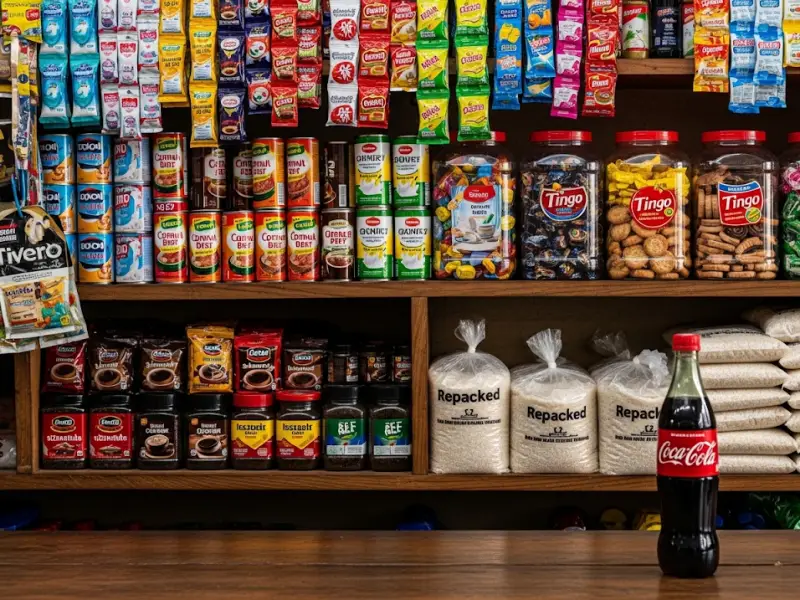
🛒 What to Sell – The Best Products for Sari-Sari Stores in 2025
The secret to a profitable sari-sari store is not just having shelves full of products, but having the right mix of items that your suki will buy every single day. Stocking fast-moving essentials while balancing higher-margin products will keep your store sustainable.
🔑 Product Categories to Prioritize
- Daily Essentials (High Demand, Low Margin)
- Rice (tingi per kilo)
- Instant noodles, canned sardines, coffee sachets, sugar
- Toiletries: shampoo, toothpaste, laundry powder, dishwashing liquid
- Drinks & Refreshments (High Volume, Consistent Demand)
- Soft drinks (returnable bottles + 1.5L PET)
- Purified water in gallons and sachets
- Energy drinks and juices
- Snacks & Comfort Food (Impulse Buys)
- Biscuits, chips, candies, chocolates
- Ice cream in cups/sticks (if freezer available)
- Bread, instant coffee, powdered juices
- Household & Everyday Needs
- Matches, candles, batteries
- Cooking oil, soy sauce, vinegar
- School supplies (ballpen, paper, notebooks)
- Add-On Services (Extra Kita)
- E-load, GCash/Maya cash-in & bills payment
- Prepaid Wi-Fi load cards
- Lotto outlet (if accredited)
📊 Fast-Moving vs. Slow-Moving Products
| Product Type | Examples | Movement | Notes |
|---|---|---|---|
| Fast-Moving Essentials | Noodles, sardines, coffee sachets, laundry powder, soft drinks | Daily | Always keep stock, low margin but high turnover |
| Impulse Buys | Candies, chips, biscuits, bread, ice cream | Daily to weekly | Higher margins, attract kids & students |
| Household Needs | Rice, cooking oil, soy sauce, vinegar | Weekly | Bulky items, buy in sacks/gallons, sell tingi |
| Seasonal Items | School supplies (June), candles (Undas), Christmas ham | Monthly/Seasonal | Plan inventory around events & holidays |
| Slow-Moving Items | Higher-priced canned goods, condiments, specialty snacks | Rare | Keep minimal stock, only if suki request |
💡 Pro Tip
Track what your neighbors buy most often in the first 2–3 months. Focus your capital on fast movers (daily essentials and drinks) and keep slow-moving items in small quantities. This way, your money is always circulating instead of being stuck on shelves.
🧮 Typical Margins by Category (Guide)
| Category | Typical Margin |
|---|---|
| Sachet essentials (shampoo, coffee, laundry) | 10–15% |
| Canned goods & noodles | 12–18% |
| Soft drinks & bottled water | 15–25% |
| Frozen items (hotdogs, tocino, ice cream) | 18–30% |
| Snacks/candies/biscuits | 20–30% |
| Household (oil, toyo, suka) | 10–15% |
| Add-on services (e-load, bills pay) | Fixed fees; ~₱2–₱10/txn |
Tip: Push high-margin items (drinks, frozen, snacks) without neglecting fast-moving essentials that keep suki coming back.
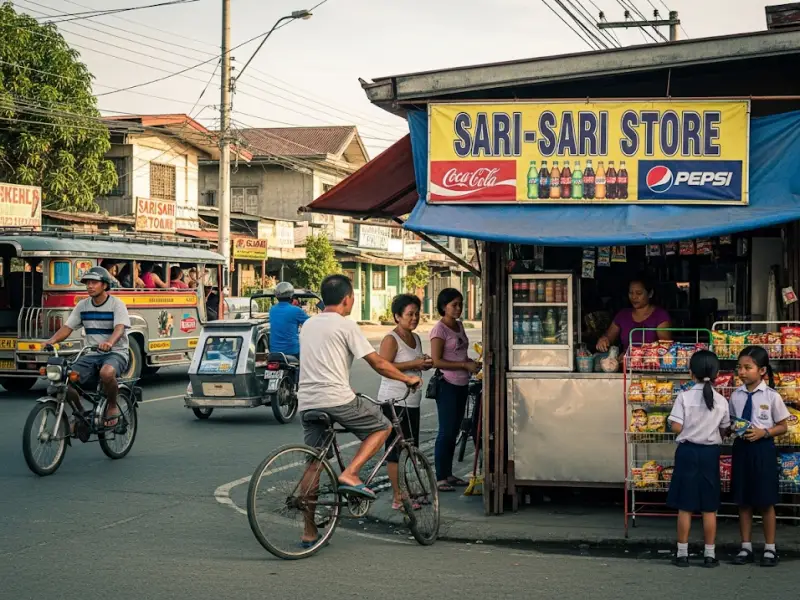
📍 Location, Space & Store Setup
Choosing the right spot and a smart layout can double your daily sales-same effort, better results.
Best Locations (what to look for)
- Foot traffic: Near tricycle/jeep terminals, school routes, morning sari-sari “corridors,” or sari-sari deserts (few competitors within 150–200m).
- Habit drivers: Paths to water refilling stations, carinderias, sari-sari staples (panaderya).
- Visibility & access: Street-facing window, shade for waiting customers, easy parking for riders.
Home-Based vs. Rented
- Home-based: Lowest overhead, built-in community trust; invest in grills, signage, and lighting.
- Rented space: Higher rent but higher foot traffic potential. Negotiate 3-month intro rent and ask for basic improvements (shelves, electricals).
Layout & Security Basics
- Counter with steel grills (cash and inventory protection)
- Eye-level fast movers (noodles, sachets, candies); bulk/slow movers up high
- Freezer/chiller near the window for impulse cold drinks
- Lighting + small CCTV/dummy cam to deter pilferage
Budget Setup Hacks
- Start with industrial racks + labeled bins; upgrade to gondola shelves later
- Reuse beverage crates as risers
- Hand-painted or vinyl signage with hours (“Open 6AM–10PM”) builds trust
Table – Starter Layout & Gear
| Item | Why it matters | Est. Cost (₱) |
|---|---|---|
| Steel grill window | Security + faster service | 3,000–6,000 |
| 2–3 metal racks | Organized, visible stock | 2,000–4,500 |
| Cash box + coin tray | Faster, accurate change | 300–600 |
| Basic chiller/freezer | Higher margins on drinks/ice | 6,000–12,000 (2nd-hand) |
| LED strip/spot light | Night visibility, safety | 300–800 |
| Simple CCTV/dummy cam | Theft deterrent | 500–2,500 |
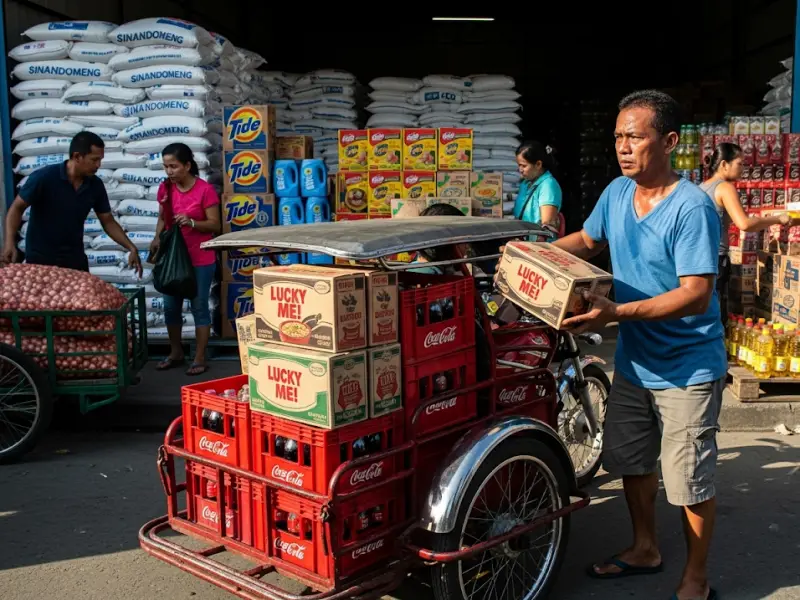
🛍️ Where to Buy Supplies – Best Sources for Sari-Sari Store Owners in 2025
Finding the right suppliers can make or break your sari-sari store. A peso difference in price might not sound like much, but when multiplied by hundreds of sachets, bottles, or packs, that’s already a big chunk of your profit. The key is knowing where to buy at the lowest possible cost while keeping stock consistent.
1. Local Wholesalers (Palengke & Divisoria-Type Stores)
- Why It Works: These are still the go-to source for many sari-sari stores because you can buy in smaller bulk (by case, box, or sack).
- Examples: Palengke dry goods sections, Divisoria in Manila, Carbon Market in Cebu, Bankerohan in Davao.
- Pro Tip: Visit early in the morning for better wholesale deals. Always haggle (tawaran) if you’re buying multiple cases.
2. Official Distributors (Coca-Cola, Pepsi, Nestlé, Unilever, Procter & Gamble)
- Why It Works: Buying directly from brand distributors gives you lowest per-unit cost, freebies, and promotions. Plus, deliveries are consistent.
- How to Apply: Approach their local sales agents (they often visit barangays) or contact them via official hotlines. Usually requires permits and minimum orders.
- Best For: High-demand items like soft drinks, coffee, powdered juices, soap, and detergents.
3. Warehouse Clubs (S&R, Landers, Puregold, Gaisano, NCCC, Metro)
- Why It Works: They offer bulk pricing and member discounts. Some even deliver directly to your store.
- Downside: Requires membership fees (S&R/Landers) and travel to their branches.
- Best For: Mid-level sari-sari stores that can stock more products at once.
4. Supermarkets (SM, Robinsons, Local Groceries)
- Why It Works: Easy access if you’re just starting and can’t buy in big bulk yet. Many supermarkets now have wholesale packs.
- Downside: Higher prices compared to direct distributors or palengke wholesalers.
- Best For: Emergency restocking (kung naubusan ka ng stock mid-week).
5. Online Wholesale Platforms (2025 Trend)
- Examples: Lazada Seller Center, Shopee Wholesale, MetroMart Business, GrabMart Partner.
- Why It Works: Convenient, often free delivery, and prices can be competitive during sales. Some even allow buy now, pay later options.
- Pro Tip: Join Viber/Facebook groups of wholesalers. Many suppliers post daily promos there and deliver straight to barangays.
6. Direct-from-Factory Deals (Rice Mills, Bakeries, Ice Plants)
- Rice: Buying direct from mills (Nueva Ecija, Isabela, Mindoro, Bukidnon) lowers cost by ₱2–₱5 per kilo.
- Bread: Tie-ups with local bakeries for daily pandesal or loaf deliveries attract morning suki.
- Ice: If you have freezer space, buying from ice plants in blocks is cheaper than buying retail packs.
📊 Comparison of Supplier Options
| Source | Pros | Cons | Best For |
|---|---|---|---|
| Local Wholesalers | Flexible bulk buying, cheaper than supermarkets | Travel required, inconsistent prices | Start-up stores |
| Official Distributors | Lowest price, promos, reliable delivery | Requires permits & minimum order | Established stores |
| Warehouse Clubs | Bulk discounts, promo bundles | Membership fees, location-limited | Mid-size stores |
| Supermarkets | Easy, accessible | Higher prices, smaller margins | Emergency restocks |
| Online Platforms | Delivery, promos, BNPL options | Shipping fees, not always cheapest | Tech-savvy owners |
| Direct-from-Factory | Cheapest for rice, bread, ice | May need larger volume | Stores with steady demand |
💡 Supply Strategy in 2025
- Mix your sources: Use palengke wholesalers for daily essentials, distributors for big brands, and online apps for promos.
- Track your margins: A ₱1 difference in noodles or coffee sachets adds up over a month. Always compare.
- Build supplier relationships: Befriend sales agents-they often give exclusive deals to suki store owners.

💵 Income Potential – How Much Can You Really Earn from a Sari-Sari Store in 2025?
A sari-sari store isn’t a guaranteed gold mine, but with the right location, stock, and diskarte, it can provide steady daily income. To set realistic expectations, let’s look at how profits work:
🔑 How Income is Calculated
- Daily Sales Volume: The total amount sold per day (ex. ₱2,000 worth of goods).
- Profit Margin: Typically 10–30%, depending on the product. Essentials like rice, sardines, and coffee sachets have lower margins (10–15%), while snacks, soft drinks, and frozen goods can reach 25–30%.
- Cash Flow: Unlike other businesses, sari-sari stores bring daily income, which can be reinvested right away.
📊 Example: Daily Sales & Profit Breakdown
| Sales Level | Example Daily Sales | Average Profit Margin | Estimated Daily Profit | Estimated Monthly Profit (30 days) |
|---|---|---|---|---|
| Small Store | ₱1,000 | 15% | ₱150 | ₱4,500 |
| Average Store | ₱2,500 | 20% | ₱500 | ₱15,000 |
| Busy Location | ₱5,000 | 20% | ₱1,000 | ₱30,000 |
| High-Traffic Store | ₱8,000+ | 25% | ₱2,000 | ₱60,000 |
⏳ Quick Break-Even Example
- Startup capital: ₱40,000 (₱28k inventory, ₱8k setup, ₱4k permits)
- Average sales/day: ₱2,500 with ~20% net margin ⇒ ₱500 profit/day
- Monthly profit (30 days): ~₱15,000
- Break-even: ₱40,000 ÷ ₱15,000 ≈ 2.7 months (assuming consistent sales and reinvestment)
Reality check: rainy weeks, school breaks, or competition can slow this-plan a 3–5 month window for safer expectations.
🥢 Real-World Scenarios
Barangay Corner Store (₱1,000–₱2,000 daily sales):
This is the classic sari-sari setup: a window counter in front of your bahay, serving kapitbahay who drop by for tingi items. Expect modest profits of ₱150–₱400 a day, which can already cover utility bills or daily groceries. This type of store thrives because of convenience-your suki will choose you over going to the palengke for small items. If you consistently offer good service (like giving credit to trusted kapitbahay), your store becomes the go-to in the area.
Near School or Terminal (₱5,000–₱8,000 daily sales):
If your store is near heavy foot traffic-like a jeepney terminal, tricycle hub, or school-you’re in the sweet spot. Students and commuters buy drinks, snacks, and quick meals almost every day. Add items like cold soft drinks, ice cream sticks, and ready-to-eat merienda, and your daily income can jump significantly. On exam weeks or rainy days, sales can spike even higher. But note: competition here is also tougher, so make sure your prices are competitive and your shelves are always full.
With Add-On Services (Extra ₱2,000–₱5,000 monthly):
Modern sari-sari stores are not just about selling goods. Many earn extra through services like e-loading, GCash/Maya cash-ins, bills payment, and even courier pickups. These don’t require much extra space or inventory, yet they add a steady stream of income. For example, a store earning just ₱3 per e-load transaction can accumulate hundreds or thousands per month if done consistently. Customers also tend to buy other items once they come to load or pay bills.
💡 Expanded Key Takeaways
- Location = Profit Multiplier: A sari-sari store on a quiet street corner will earn differently from one near a busy kanto, terminal, or school. Where you put your store matters as much as what you sell.
- Product Mix is Everything: Essentials keep people coming back, but high-margin products (soft drinks, ice cream, frozen goods) are what push profits higher. Strike a balance between necessities and impulse buys.
- Services are the Future: With cashless payments and e-load in demand, sari-sari stores that add services have a competitive edge. Think of your store not just as “pabili ng noodles” but as a mini community hub.
- Consistency Builds Trust: Customers prefer stores that are always stocked, reliable, and welcoming. Even if you’re not the cheapest, being the most consistent (open daily, suki-friendly) can win loyalty.
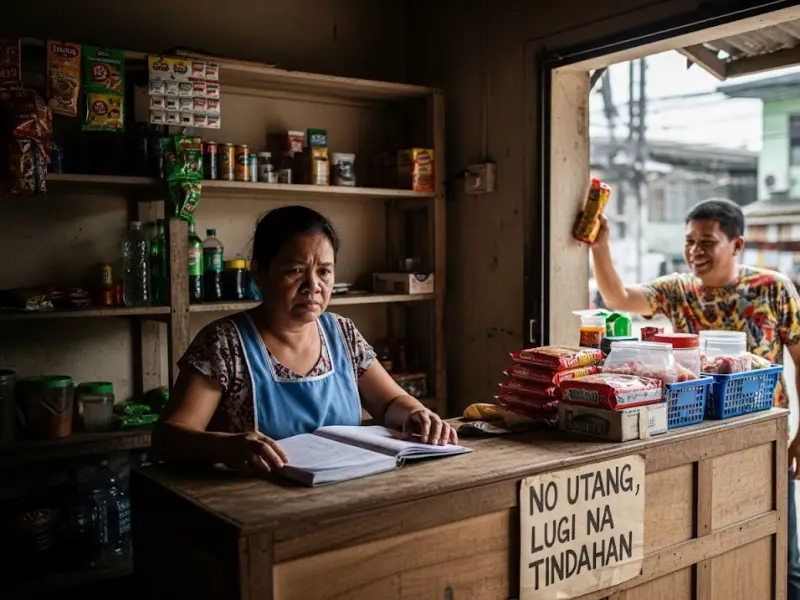
⚠️ Common Challenges & How to Avoid Them
Running a sari-sari store sounds simple-sell tingi, earn daily. But in reality, many owners close within months because they underestimate the pitfalls. Here are the most common problems and how to deal with them:
1. “Utang” Culture (Credit to Neighbors)
- The Challenge: In Filipino communities, it’s normal for kapitbahay to ask for credit (“Pautang muna, bayaran sa sahod”). While it helps build goodwill, it can easily wipe out your profit if left unmanaged.
- How to Avoid It:
- Set a clear rule: Only allow utang for trusted suki, with a limit (e.g., ₱200 max).
- Keep a notebook ledger or use an app (like Tindahan Ni Bossing or Growsari) to track balances.
- Collect regularly (end of week, payday). Don’t let debts pile up.
2. Spoilage & Expired Goods
- The Challenge: Snacks, bread, dairy, and soft drinks have expiry dates. If not managed well, you’ll throw away profit.
- How to Avoid It:
- Follow FIFO (First In, First Out): Sell older stocks first.
- Buy only what sells fast. Don’t stock 10 cases of soft drinks if you only sell 2 a week.
- Monitor expiry dates monthly and put slow-moving items on promo (e.g., “₱5 candy for ₱4 each”).
3. Strong Competition
- The Challenge: In some barangays, sari-sari stores are literally on every street corner. If you’re not careful, you’ll just split the same market with 3–5 other tindahans.
- How to Avoid It:
- Differentiate with extra services (e-load, bills payment, delivery).
- Be consistent in store hours. If others open at 8AM, open at 6AM to capture early buyers.
- Keep your store tidy and friendly-believe it or not, many suki prefer a clean tindahan with approachable owners.
4. Cash Flow Problems
- The Challenge: Daily income may look big, but if you keep pulling out money for personal use, you’ll soon have no capital left for restocking.
- How to Avoid It:
- Separate business money from personal money. Use an envelope system or a second e-wallet account just for your store.
- Reinvest at least 70–80% of daily profits back into restocking.
- Track expenses weekly so you know if you’re growing or shrinking.
5. High Utility Bills & Overheads
- The Challenge: Adding a freezer or chiller is great for sales, but it also increases your kuryente (electric bill).
- How to Avoid It:
- Use energy-efficient appliances and unplug when not in use.
- Limit use of lights and fans during daytime.
- Compute if sales from frozen goods (ice, ice cream) really outweigh the added electricity cost.
6. Security & Theft
- The Challenge: Petty theft (by outsiders or even household members) eats into profit.
- How to Avoid It:
- Install basic grills or screen windows for protection.
- Use a cash box and don’t leave money scattered on the counter.
- Train family members helping in the store to always record sales.
📊 Quick Risk & Solution Snapshot
| Challenge | Risk Level | Practical Solution |
|---|---|---|
| Utang Culture | High | Limit credit, track in ledger/app |
| Spoilage | Medium | FIFO system, buy only fast movers |
| Competition | High | Offer services, open earlier, stay consistent |
| Cash Flow | Very High | Separate money, reinvest profits |
| Utilities | Medium | Use efficient appliances, compute ROI |
| Security | Medium | Grills, cash box, record all sales |
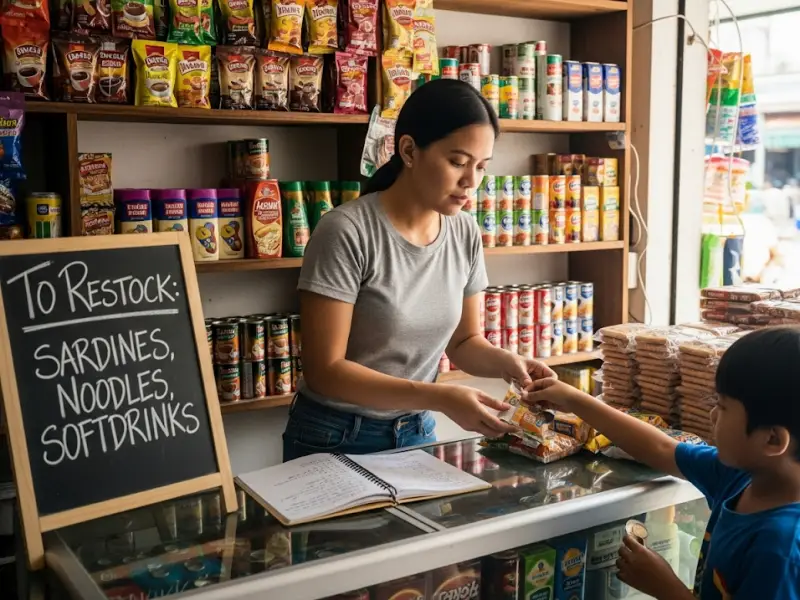
🛒 Daily Operations & Smart Store Management
Running a sari-sari store isn’t just about opening the tindahan and waiting for suki to come. The most successful store owners treat it like a real business: disciplined, consistent, and customer-focused. Here’s how to manage your day-to-day operations.
⏰ Store Hours Matter
- Be Consistent: Customers value a store that’s always open at the same hours. If you open at 6:00 AM today and 9:00 AM tomorrow, people will look for other stores.
- Early Advantage: Opening early captures morning buyers (tricycle drivers, workers, kids buying baon).
- Late-Night Edge: If safe, staying open until 10:00–11:00 PM makes you the go-to for last-minute soft drinks, noodles, or load.
📦 Smart Inventory Management
- Keep Bestsellers in Stock: Coffee sachets, soft drinks, sardines, instant noodles, rice, and bread. Running out even for a day can lose your suki.
- Restock Weekly: Pick one “palengke day” or supplier delivery day to replenish everything at once. This saves time and transportation costs.
- Track Movement: List fast movers (e.g., Lucky Me Pancit Canton, Coke, Ginebra) vs. slow movers (expensive chocolates, rarely bought condiments). Cut back on slow movers.
🤝 Customer Service Filipino-Style
- Be Friendly & Approachable: Greet customers by name if possible-“Oh, Mang Tonyo, load ulit?” builds loyalty.
- Trust & Transparency: Always give exact change, even if it’s just ₱1. Small lapses damage credibility.
- Add Value: Simple gestures like chilling drinks, giving plastic ice, or offering sukli candies make customers feel valued.
💡 Tricks to Boost Daily Kita
- Upsell Subtly: When someone buys noodles, ask: “Gusto niyo rin po ng itlog?” (Would you like eggs with that?).
- Bundle Promos: Pair items (“Buy 5 sachets of Kopiko, get ₱2 off”).
- Seasonal Stocking: Sell school supplies in June, Christmas goodies in December, halo-halo ingredients in summer.
- Add a Freezer/Chiller: Soft drinks, ice cream, and frozen meats significantly raise average sales per day.
📊 Sample Daily Routine of a Successful Store Owner
| Time | Task | Why It Matters |
|---|---|---|
| 5:30 AM | Open store, sweep, arrange stock | Capture morning rush |
| 7:00 AM | Record yesterday’s sales & cash count | Track progress, avoid lost capital |
| 9:00 AM | Restock shelves, check expiry dates | Keep tindahan presentable & organized |
| 12:00 PM | Lunch break, let family member handle store | Maintain service continuity |
| 2:00 PM | Check freezer, refill ice/water | Peak merienda time, higher drink/snack sales |
| 6:00 PM | Supplier follow-ups, prepare change | Evening rush (tricycle drivers, workers) |
| 9:00 PM | Record cash, close store (if safe) | Secure earnings, prepare for next day |
📣 Marketing Your Store – How to Stand Out in a Crowded Barangay
In 2025, sari-sari stores are everywhere-from big street corners to small bahay tindahans tucked in alleys. The challenge isn’t just selling; it’s making customers choose your store over others. Here’s how you can stand out without spending too much.
🏠 Build Strong Suki Loyalty
- Consistency Wins: If your tindahan is always open and always stocked, suki will choose you out of habit.
- Small Gestures Matter: Add sukli candies when coins are short, chill soft drinks for free, or offer plastic ice for take-home.
- Know Their Needs: Remember your regulars. If Aling Nena always buys Ginebra on Friday, keep one ready for her.
📱 Embrace Social Media (Yes, Even for Tindahans!)
- Facebook Barangay Groups: Post that your store has new stock (e.g., “Fresh pan de sal every morning!”).
- Messenger Orders: Allow neighbors to message you for small deliveries-especially if teens in the house can do the drop-off.
- TikTok Promotions: Some tindahans post funny or creative short videos (“Pabili po! POV at the sari-sari store”) to draw in younger buyers.
🎉 Promotions & Creative Diskarte
- Bundle Promos: ₱20 packs of mixed candies or biscuits for kids.
- Seasonal Deals:
- June: School supplies bundles.
- Christmas: Ready gift packs with noodles + sardines.
- Summer: Halo-halo or cold gulaman.
- Raffle-Style Gimmicks: For every ₱50 purchase, give a raffle entry for small prizes like groceries. Simple but effective.
👀 Presentation is Key
- Clean & Organized: Customers trust a tindahan that looks neat and well-stocked. Avoid dusty sachets or cluttered counters.
- Signage: A small, bright sign (“Aling Marites Store – Open 6AM–10PM”) makes your store look professional.
- Lighting: At night, a well-lit store is not only safer but also more inviting.
🤝 Partner with Local Community
- Barangay Events: Offer sponsorship (e.g., free mineral water for a basketball game) to gain visibility.
- School Tie-Ups: Supply baon snacks for teachers or students.
- Delivery Riders: Become a go-to stop for riders-keep Gatorade, coffee sachets, and easy snacks ready.
📊 Quick Marketing Ideas at a Glance
| Strategy | Cost | Potential Impact |
|---|---|---|
| Loyalty gestures (sukli candies, chilled drinks) | Low | Builds strong suki base |
| FB group posts & Messenger orders | Free | Expands reach beyond immediate kapitbahay |
| Seasonal bundles & promos | Low–Medium | Increases sales during peak times |
| Clean signage & good lighting | Medium (₱500–₱1,500) | Makes store stand out visually |
| Barangay event tie-ups | Low | Builds goodwill and visibility |
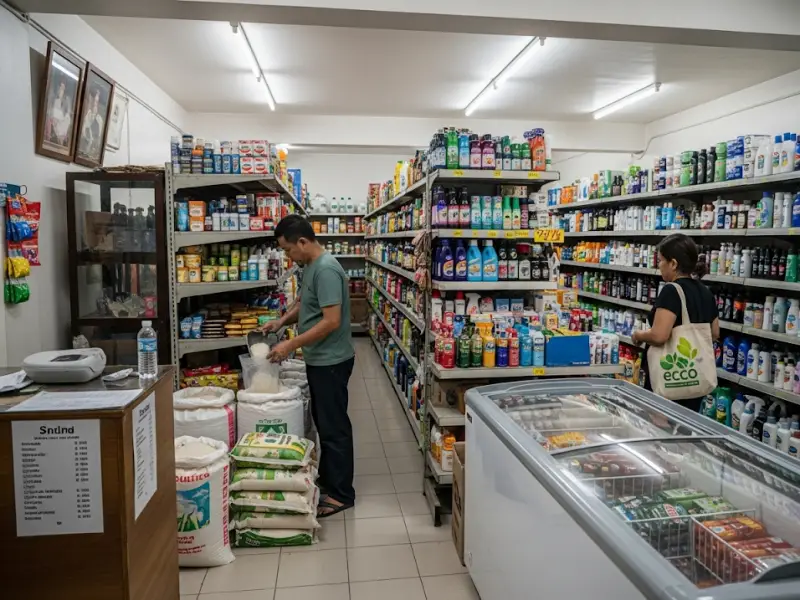
🚀 Growth & Expansion – From Tindahan to Mini-Grocery
- When to scale: You’re consistently selling out fast movers, daily profit ≥ ₱700, and you’re turning away demand (e.g., customers ask for frozen meats, bread, rice refills).
- What to add first:
- Bread drop-off + rice refilling (high repeat purchase)
- POS/app (Tindahan Ni Bossing, Growsari, or simple Excel) for better tracking
- Delivery radius (Messenger/Viber orders; teens can do 3–5 drop-offs after school)
- Mini-grocery path (3–6 months):
- Add a second freezer/chiller; expand to fresh eggs, basic produce (onions, garlic), and household gallons (oil, soy, vinegar)
- Partner with a local bakery and water refilling station
- Negotiate direct distributor terms (Coke/Pepsi/Nestlé) for better per-case pricing
- Simple KPI to watch: Inventory turns (how many times you reorder each item per month). Push items that turn ≥ 2×/month; drop those that sit.
❓ Frequently Asked Questions (FAQs)
- How much profit can I realistically make per day?
For small home-based stores, ₱150–₱400/day is common; near schools/terminals, ₱1,000+/day is possible with drinks and frozen add-ons, as long as inventory is well-managed. - Do I need a freezer right away?
Not required, but a chiller/freezer usually lifts average ticket size through cold drinks and frozen items-often worth the extra kuryente if you have steady demand. - What are the best-selling items today?
Fast movers: instant noodles, sardines, coffee sachets, laundry powder, soft drinks, bread. Keep them at eye level and always in stock. - How do I handle utang without offending neighbors?
Offer small limits to trusted suki (e.g., ₱200), record everything in a ledger/app, and collect weekly/payday. Clear rules keep friendships intact. - Is a sari-sari store still viable in the city?
Yes-foot traffic + convenience still win. Differentiate with chilled drinks, small combos, and bills payment/e-load. - Where should I buy stock to get the lowest prices?
Mix palengke wholesalers (flexible), official distributors (lowest per-case cost), and online wholesale promos during big sales. - How do I know when it’s time to scale?
If you’re selling out fast movers weekly and hitting ₱700–₱1,000 profit/day consistently, start adding higher-margin lines and a second freezer. - What simple system helps most with cash flow?
Separate business money from personal, reinvest 70–80% of daily profits into restocks, and do a weekly inventory count.
❤️ From Window Counter to Family Cornerstone
A sari-sari store isn’t just a shelf of sachets-it’s the heartbeat of a street. Every cold Coke, every “pabili po,” every suki you greet by name builds something bigger than daily sales. If you start small, plan smart, and show up consistently, this little tindahan can fund the dreams in your household-tuition, a second freezer, maybe even a mini-grocery down the line.
Start with what you have, grow with what your suki teaches you, and keep your diskarte sharp. The door’s already open.



